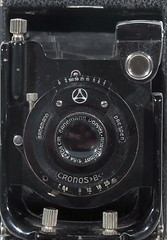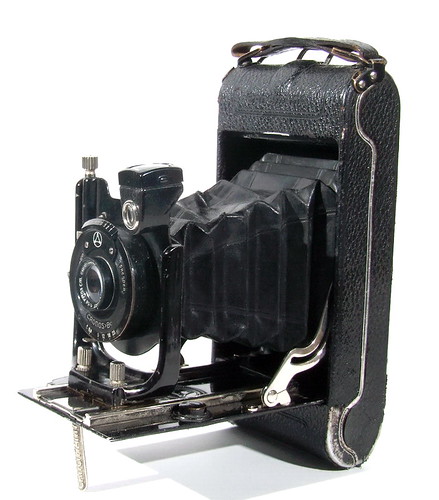Ernemann Bob
The Bob series are folding cameras for various sizes of both plates and rollfilm, made by Ernemann of Dresden from about 1902 until the company took part in the merger to create Zeiss Ikon in 1926.[1] There is also a cylindrical cardboard camera for five 4.5x6cm plates simply named 'Bob', from about 1900-03: McKeown shows an example.
There were numerous folding models:
| Model | Production | Rollfilm Formats | Plate Formats |
| Bob 00 | 1914-1925 | 6x9; 8.5x10 | 6.5x9; 9x12 |
| Bob 0 | 1911-1926 | 8x10.5; 8.5x14 | 9x12; 9x14 |
| Bob I | 1903-26[1] | 4x6.5; 6.5x9; 8x10.5; 8.5x14 | |
| Bob II | 1903-1926[1] | 8x10.5 [2]; 8.5x14; 10x12.5 | 9x12; 9x14; 9x12 |
| Bob IIa | 8x10.5; 8.5x14 | 9x12; 9x14 | |
| Bob III | 1904-10 1925-6 |
3½x4½ inch 6x9 |
9x12 |
| Bob IV | |||
| Bob V | 1924-1926 | 4x6.5; 6x6; 6x9; 6.5x11; 7.25x12.5 | |
| Bob V stereo | 1909-c1913[1] | 4.5x10.7 | 4.5x10.7 |
| Bob XV | 1914— | 4x6.5; 8.5x10 | |
| Bob XV stereo | 1913-18[1] | 4.5x10.7 cm |
Bob 00
- Type: folding camera
- Format: various: 6x9 rollfilm, 6.5 x 9 plates, 8 x 10.5 rollfilm, 9 x 12 cm plates
- Years of production: 1914 to 1925[3]
- Lenses:
- Ernemann Detektiv Aplanat (a Rapid Rectilinear type)
- 1:6.8/105 mm
- Ernemann Detektiv Aplanat (a Rapid Rectilinear type)
Bob 0
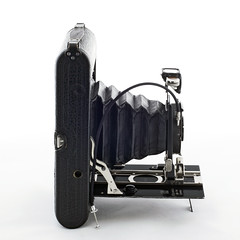
|

| |
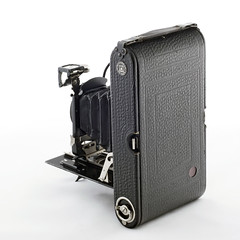
| ||
images by Abdishev (Image rights) | ||
Specifications
- Type: folding camera
- Format: various: 8x10.5 cm rollfilm, 9x12 cm plates; 8x14 cm rollfilm, 9x14 cm plates
- Years of production: 8x10.5 type 1911-1926; 8x14 type 1917-1926[4]
- Lenses:
- 8x10.5 type
- Ernemann Doppel Objectiv 1:11
- Ernemann Detektiv Aplanat 1:6.8, 125mm
- Ernemann Doppel Anastigmat Vilar 1:6.8, 135mm
- 8x14 type
- Ernemann Doppel Objectiv 1:11
- Ernemann Detektiv Aplanat 1:6.8, 165mm
- Ernemann Doppel Anastigmat Vilar 1:6.8, 165mm
- 8x10.5 type
- Viewfinder: brilliant finder
- Focusing: by sliding bed, without gears
- Front shift: horizontal & vertical
- Dimensions & weight:
- 8x10.5 type: 15 cm extended; 3.8x11.5x20.5 cm; 0.550 kg
- 8x14 type: 18 cm extended; 4.6x11.8x24 cm; 1.150 kg
Bob I
The Bob I is a folding camera for roll film. Vertical and horizontal movements of the front standard are possible with this camera. It was made for different film sizes.
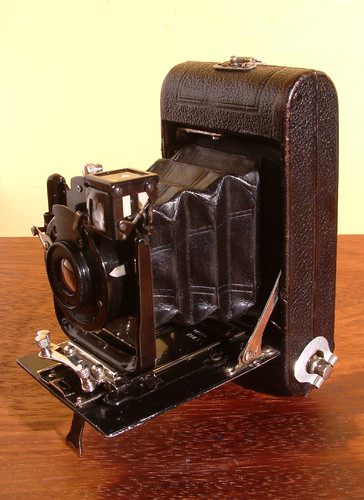
|
| Bob I, 127 film, with Detektiv Aplanat f/6.8 and radial-lever focusing image by Dustin McAmera (Image rights) |
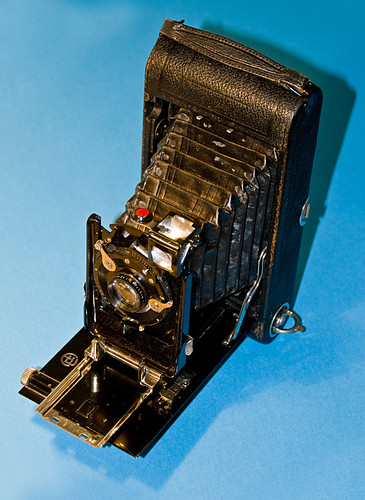
|
| Bob I, 8.5x14 format with Zeiss Tessar 1:6.3, 150mm and rack-and-pinion focusing image by Dirk HR Spennemann (Image rights) |
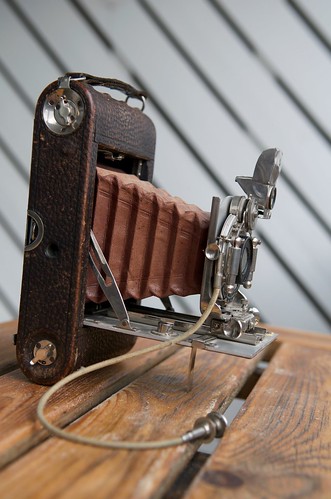
|
| Bob I image by Stig Bordsenius (Image rights) |
Specifications
- Type: folding camera
- Format: various: 4x6.5, 6.5x9, 8x10.5, 122 (8.5x14 Postcard format)
- Years of production: 1914 to 1926[5]
- Lenses:
- Ernemann Detektiv Aplanat
- 1:6.8, 80mm
- 1:6.8, 105mm
- 1:6.8, 135mm
- 1:6.8, 165mm
- Ernemann Doppel Anastigmat Ernar
- 1:6.8, 80mm
- Ernemann Doppel Anastigmat Vilar
- 1:6.8, 105mm
- 1:6.8, 135mm
- 1:6.8, 165mm
- Goerz Dagor
- 1:6.8, 80mm
- 1:6.8, 105mm
- 1:6.8, 135mm
- 1:6.8, 150mm
- Carl Zeiss Jena Tessar
- 1:6.3, 90mm with 4 elements in 3 groups
- 1:6.3, 120mm
- 1:6.3, 135mm
- 1:6.3, 150mm
- Ernemann Detektiv Aplanat
- Shutter:
- Ernemann two blade shutter with speeds 1/25 to 1/100 sec.
- Ernemann with speeds 1/25 to 1/300 sec.
- Viewfinder: brilliant type
Bob II
The Bob II was produced from 1903 to 1926. It is similar to Bob I, but with double extension. A great number of shutter/lens combinations was offered. The Bob II (also named Bob IIa in catalogs of 1912-1913) was produced in three sizes: 10x12.5; 8x10.5 (chrome) & 8x10.5 (black); 8.5x14. The camera was also sold by Stöckig as “Union XXVI” (1903-c1906)

|
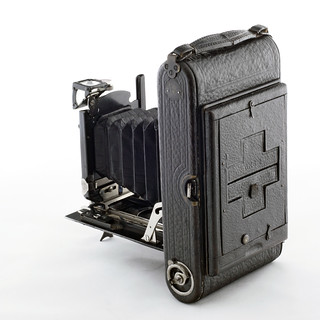
|
images by Abdishev (Image rights) | |
Specifications for 10x12.5 (1903-1909)
- Type: folding roll-film & plates camera, lens stand with 2 round posts (1903-c1906); or chromed U shape (c1906-1909).
- Format: 10x12.5 roll-film, 9x12 plate, also 8x10.5 Premofilms
- Years of production: 1903-1909
- Lenses:
- Ernemann Detektiv Aplanat 1:6.8
- Ernemann Doppel Anastigmat 1:6, 135mm
- Ernemann Doppel Anastigmat 1:5.4, 135mm
- Goerz Doppel Anastigmat 1:6.8, Serie III, No.1
- Steinheil Orthostigmat 1:6.8, No.4
- Steinheil Unofokal 1:6, No.3
- Collinear Serie III, No.3
- Zeiss Tessar Serie IIb, No.5
- Rodenstock Imagonal 1:6, No.3
- Shutter: Bob-Sektor
- Viewfinder:
- Newton finder (1903-c1906)
- Brilliant type with cover (c1906-1909)
- Focusing: by rack & pinion
- Front shift: vertical and horizontal front shift
- Dimensions & weight: 36 cm extended; 5x12x20 cm; 1.000 kg
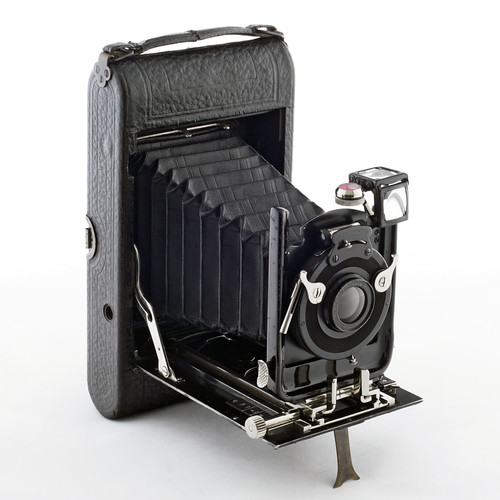
|
| Ernemann Bob II 8x10.5 (c1912-1913) with Detectiv Aplanat 1:6.8 No.1 (135mm) image by Abdishev (Image rights) |
Specifications for 8x10.5 & 8.5x14 (1909-c1913)
- Type: folding roll-film & plates camera, lens stand with chromed U shaped posts.
- Format: 8.5x14 roll-film, 9x14 plate; after c1911 also 8x10.5 roll-film, 9x12 plate
- Years of production: 1909-c1913, same as Bob IIa of c1911-c1913
- Lenses types:
- 8x10.5 type:
- Ernemann Detektiv Aplanat 1:6.8
- Ernemann Anastigmat 1:7.2, 135mm
- Ernemann Doppel Anastigmat 1:6, 135mm
- Ernemann Doppel Anastigmat Ernon 1:6.8, 135mm
- Goerz Dagor 1:6.8, 135mm
- Zeiss Tessar 1:6.3, 135mm
- 8.5x14 type:
- Ernemann Detektiv Aplanat 1:6.8
- Ernemann Anastigmat 1:7.2, 150mm
- Ernemann Doppel Anastigmat 1:6, 150mm
- Ernemann Doppel Anastigmat Ernon 1:6.8, 150mm
- Goerz Dagor 1:6.8, 150mm
- Zeiss Tessar 1:6.3, 150mm
- 8x10.5 type:
- Shutter:
- Bob-Sektor
- Automat
- Auto-Sektoren
- Viewfinder: brilliant type
- Focusing: by rack & pinion
- Front shift: vertical and horizontal front shift
- Dimensions & weight:
- 8x10.5 type: 25 cm extended; 4x11.5x20.5 cm; 1.000 kg
- 8.5x14 type: 34 cm extended; 4.5x12x24 cm; 1.100 kg
Specifications for 8x10.5 & 8.5x14 (c1913-1926)
- Type: folding roll-film & plates camera, lens stand with black U shaped posts.
- Format: 8x10.5 roll-film, 9x12 plate; 8.5x14 roll-film, 9x14 plate
- Years of production: c1913-1926
- Lenses types:
- 8x10.5 type:
- Ernemann Ernastigmat 1:6.8, 135mm
- Ernemann Detektiv Aplanat 1:6.8, 135mm
- Ernemann Doppel Anastigmat Vilar 1:6.8, 135mm
- Ernemann Anastigmat Ernar 1:6.3, 135mm
- Ernemann Doppel Anastigmat 1:6, 135mm
- Ernemann Doppel Anastigmat Ernon 1:6.8, 135mm
- Goerz Dagor 1:6.8, 135mm
- Zeiss Tessar 1:6.3, 135mm
- 8.5x14 type:
- Ernemann Ernastigmat 1:6.8, 165mm
- Ernemann Detektiv Aplanat 1:6.8, 165mm
- Ernemann Doppel Anastigmat Vilar 1:6.8, 165mm
- Ernemann Anastigmat Ernar 1:6.3, 165mm
- Ernemann Doppel Anastigmat 1:6, 150mm
- Ernemann Doppel Anastigmat Ernon 1:6.8, 150mm
- Goerz Dagor 1:6.8, 150mm
- Zeiss Tessar 1:6.3, 150mm
- 8x10.5 type:
- Shutter:
- Automat
- Auto-Sektoren
- Viewfinder: brilliant type
- Focusing: by rack & pinion
- Front shift: vertical and horizontal front shift
- Dimensions & weight:
- 8x10.5 type: 25 cm extended; 4x11.5x20.5 cm; 1.000 kg
- 8.5x14 type: 34 cm extended; 4.5x12x24 cm; 1.100 kg
Bob IIa
Specifications
- Type: folding roll-film & plates camera, lens stand with chromed U shaped posts.
- Format: 8.5x14 roll-film, 9x14 plate; after 1911 also 8x10.5 roll-film, 9x12 plate
- Years of production: 1911-1913, same as Bob II of 1909-1913
- Lenses:
- 8x10.5 type:
- Ernemann Detektiv Aplanat 1:6.8
- Ernemann Anastigmat 1:7.2, 135mm
- Ernemann Doppel Anastigmat 1:6, 135mm
- Ernemann Doppel Anastigmat Ernon 1:6.8, 135mm
- Goerz Dagor 1:6.8, 135mm
- Zeiss Tessar 1:6.3, 135mm
- 8.5x14 type:
- Ernemann Detektiv Aplanat 1:6.8
- Ernemann Anastigmat 1:7.2, 150mm
- Ernemann Doppel Anastigmat 1:6, 150mm
- Ernemann Doppel Anastigmat Ernon 1:6.8, 150mm
- Goerz Dagor 1:6.8, 150mm
- Zeiss Tessar 1:6.3, 150mm
- 8x10.5 type:
- Shutter:
- Bob-Sektor
- Automat
- Auto-Sektoren
- Viewfinder: brilliant type
- Focusing: by rack & pinion
- Front shift: vertical and horizontal front shift
- Dimensions & weight:
- 8x10.5 type: 25 cm extended; 4x11.5x20.5 cm; 1.000 kg
- 8.5x14 type: 34 cm extended; 4.5x12x24 cm; 1.100 kg
Bob III
The original Bob III, made from 1904, is for 9x12 cm plates, or quarter-plate exposures (3½x4½ inch or 8.3x10.8 cm) on roll-film. An Ernemann catalogue states that the construction is mostly of aluminium, with American leather covering, leather bellows, and nickel fittings.[6] The camera has triple-extension bellows, allowing the use of the rear group of any of the symmetrical lenses on its own (see the article on separable lenses), and has front rise and shift. It has a brilliant finder, which rotates for horizontal or vertical use of the camera. Another folding camera named Bob III was made in the 1920s, in the last years before Ernemann became part of Zeiss Ikon. This is for 6x9 cm exposures on roll-film.
Specifications
| Years:[1] | 1904-10 | 1925-6 |
| Type: | folding camera | |
| Format: | 9x12 plate, 3¼x4¼ inch roll-film | 6x9 roll-film |
| Lenses: |
|
Ernemann Erid 10.5 cm f/8 |
| Shutter: | Cronos-A | 'Bob' T and I |
Bob V

|
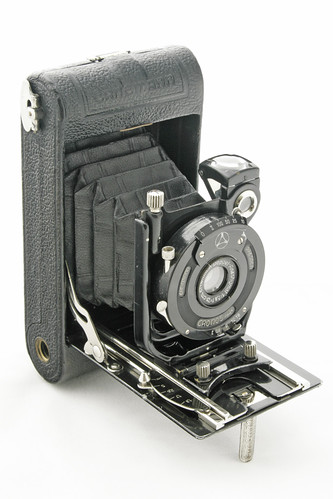
| |
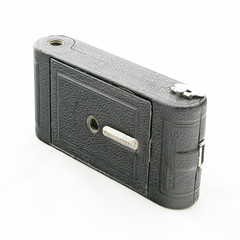
| ||
| Bob V 4x6.5 (1924) with Ernemann Doppel-Anastigmat 1:6.8 75mm images by Abdishev (Image rights) | ||
|
|
| ||||||
| Bob V 6x9 (1924) with Ernemann Doppel-Anastigmat "Vilar" 105mm 1:6.8 Images by Süleyman Demir (Image rights) | ||||||||

|
| Bob V 6.5x11(1924) with Ernemann Doppel-Anastigmat 1:6.8 F=12.0 cm. image by Jaap Schelvis (Image rights) |
Specification
- Type: folding roll-film camera
- Format: 4x6.5; 6x6; 6x9; 6.5x11; 7.25x12.5 cm
- Years of production: 1924-1926
- Lenses:
- Ernemann Ernastigmat 1:6.8 (only for 4x6.5 & 6x6)
- Ernemann Doppel Anastigmat Vilar 1:6.8
- Ernemann Doppel Anastigmat Ernar 1:6.3
- Zeiss Tessar 1:6.3
- Ernemann Ernoplast 1:4.5
- Ernemann Ernotar 1:4.5
- Zeiss Tessar 1:4.5
- Lens focal lengths:
- 4x6.5 & 6x6 f=75mm
- 6x9 f=105mm; 1:4.5 & 1:4.3 lenses with f=120mm
- 6.5x11 f=120mm
- 7.25x12.5 f=135mm
- Shutter:
- Viewfinder: brilliant type
- Focusing: radial-lever
- Front shift: Vertical with micrometer screw, Horizontal front shift.
Bob V stereo
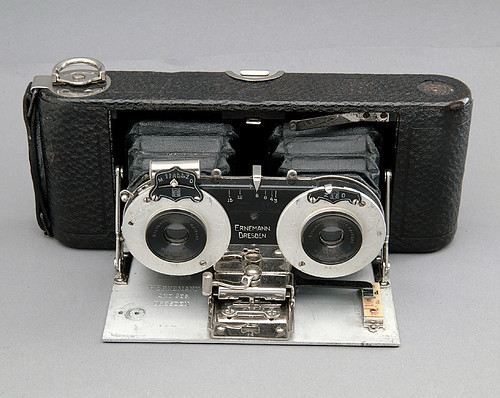
|
| Bob V stereo with Detectiv Aplanat lenses (missing viewfinder) image by Geoff Harrisson (Image rights) |
Specifications
- Type: folding-bed stereo camera for plates or rollfilm.
- Format: 45x107 mm
- Years of production: 1909-13
- Lenses:
- Detectiv Aplanat 1:6.8
- Em Anastigmat 1:7.2
- Ernon Anastigmat 1:6.8
- Goerz Dagor 1:6.8
- Doppel-anastigmat 1:6
- Shutter:
- Stereo Automat (everset shutter)
- Auto sector
Bob XV
Specifications
- Type: folding camera[7]
- Format: various, 4x6.5, 8.5x10
- Years of production: 1914—
- Lenses:
- Shutter:
- Viewfinder: brilliant type
| German, French & Italian Cameras using 127 film | |||
| G e r m a n y |
3×4 | rigid | Dreivier | Futuro | Gewirette | Kolibri Parvola | Pupille | Ranca | Reporter | Puck |
| folding | Baby Ikonta | Baldi | Dolly | Goldi Gucki | Ingo | Korelle | Makinette Metharette | Perkeo | Vollenda | ||
| 4x4 | Navax | Paxina Electromatic | Rothlar | ||
| 4x6.5 | Bella | Billy | Bob | Dolly | Goldi Gucki | Korelle | Panta | Parvola Piccolette | Rio | Ultrix | ||
| TLR | see German TLRs | ||
| F r a n c e |
3×4 | rigid | Fotobaby | Lynx | Super-Boy |
| folding | Derby-Lux | Elax | ||
| pseudo TLR | Auteuil | Longchamp | ||
| 4×4 | rigid | Impera | Marly | Pari-Fex | Rubi-Fex | Top | |
| 4×6.5 | rigid | Photo-Magic | |
| I t a l y |
3x4 | Comet | Comet III | Cometa | Euralux Ibis | Maxima | Piccolo | Tanit | |
| 4x4 | Comet | Euralux | Ibis | ||
| 4x6.5 & other | Alfa | Delta | Relex | Rolet | Rondine | ||
Notes
- ↑ 1.0 1.1 1.2 1.3 1.4 1.5 McKeown, James M. and Joan C. McKeown's Price Guide to Antique and Classic Cameras, 12th Edition, 2005-2006. USA, Centennial Photo Service, 2004. ISBN 0-931838-40-1 (hardcover). ISBN 0-931838-41-X (softcover). p267-269.
- ↑ chrome & black
- ↑ Catalogue Photo-Sport 1922, p. 17.
- ↑ Catalogue Photo-Sport 1922, p. 17.
- ↑ Catalogue Photo-Sport 1922, p. 18.
- ↑ Catalogue Ernemann Cameras sind die Besten; Anleitung; Liste No. 91, p18. The cataloge is undated, but describes the Bob III (1904-10) as new; at Ciné-Ressources.
- ↑ The Photo Miniature 1914
Links
- Bob I, small variant at Camera Site
- Forum discussion about bigger variant at Photo.net

